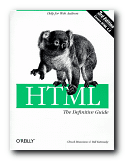the encyclopaedia of HTML coding and web design
Most people in the academic and business world are still using HTML Standard 2.0 browsers – partly because of corporate lethargy and partly because upgrading is so costly and disruptive in big organisations. At least these people have had the good fortune to miss out the Standard 3.0 phase, which was something of a dog’s breakfast. Designers however (the people who actually create the Web pages for our consumption) are always keen to make the screen more attractive and escape the confine of earlier standards. In fact they have a doubly difficult job. They might wish to adopt the latest features, but if their sites are to be viewable by people still lumbered with older browsers, they are also under constraint to make their pages ‘backwardly compatible’. This is no easy task.
 The first edition of Musciano and Kennedy’s book on HTML was rather boldly entitled The Definitive Guide. However, many of the predictions they made then have been substantiated by subsequent meetings of the W3C committee, which decides on these standards. [It’s recently been rumoured that both Microsoft and Netscape try to pack this committee with their appointees.]
The first edition of Musciano and Kennedy’s book on HTML was rather boldly entitled The Definitive Guide. However, many of the predictions they made then have been substantiated by subsequent meetings of the W3C committee, which decides on these standards. [It’s recently been rumoured that both Microsoft and Netscape try to pack this committee with their appointees.]
The third edition of their reference manual offers an update which includes the latest additions to Standard 4.0 of the official HTML code. They claim that this is a ‘clearer and cleaner standard’ than any previous, but they also admit that Netscape and Microsoft incorporate features not included in the present standard. Fortunately, they take a realistic view of this browser war and make clear which standards are adopted (or not) by the Big Two. So what’s really new here?
The answer is ‘Quite a lot’. The Forms, Tables, and Frames chapters have all become bigger, and JavaScript and DHTML make an appearance. They also cover Layers, Multiple Columns, and creating white space. The big new item of course is a whole chapter on Cascading Style Sheets – a development which has come about precisely because of the shortcomings in standards 1.0, 2.0, and 3.0 – and they recognise in this respect that print publications just can’t keep up with Web developments (which is a brave and honest admission for authors of computer manuals). A section on image formats (.gif and .jpg) is also new – but beware! there are Netscapisms at every turn.
I still find it difficult to remember what is an attribute, a physical style, and why some tags are ‘deprecated’. They even include some which are now obsolete (for historical reasons) which just goes to illustrate their thoroughness. However, you still have to be prepared for a rather abstract manner of expression:
like most other tagged segments of content, user-related events can happen in and around the BLOCK QUOTE tag
But having used the first edition regularly over the last year or two, I can confirm that their manner of writing is amply compensated by the reliability of the advice they offer.
Obviously you should buy this latest edition, but it’s reassuring to know that Musciano and Kennedy continue to offer a guide which stays within the limits of the latest HTML standard, whilst recognising that you will want to go beyond it. In this regard the publisher generously offers an online update.
The usual high quality O’Reilly production values obtain: good quality paper, clear print, consistent layout, and their elegant house font of ITC Garamond. Multiple indexes include HTML grammar, quick tag reference, CSS quick reference, the HTML 4.0 document type definition, character entities, and colour names and values. To a newcomer these might seem like boring technical catalogues – until you see the horror of your Web pages in a browser you don’t normally use. Then you’ll be glad of the reassurance of safe colours and the correct ASCII number for that ampersand or angled bracket.
© Roy Johnson 2006
Chuck Musciano & Bill Kennedy, HTML: The Definitive Guide (sixth edition) Sebastopol: O’Reilly, 2006, pp.678, ISBN 0596527322
More on technology
More on digital media
More on web design
More on computers